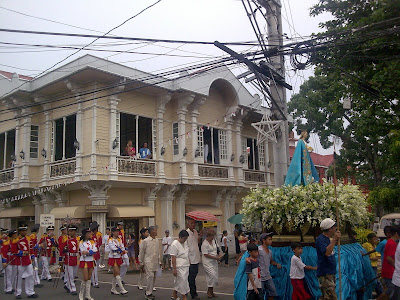By Niña Catherine Calleja
Southern Luzon Bureau
Philippine Daily Inquirer
First Posted 04:31:00 12/27/2007
Original article here
PILA, Laguna, Philippines—It was just a stone placed at the heart of the town plaza with the words “a town declared a historical landmark” engraved on it.
But the historical marker has become a source of pride for the people here.
Thirty-six structures, including the 200-year-old St. Anthony of Padua Church, a school and a municipal hall, were declared preserved and protected by the National Historical Institute (NHI) on May 17, 2000.
 On Dec. 4, former President Fidel Ramos and NHI Executive Director Ludovico Badoy unveiled the marker.
On Dec. 4, former President Fidel Ramos and NHI Executive Director Ludovico Badoy unveiled the marker.
Houses also homes
According to anecdotes, Pila was spared during the World War II because American bombers failed to spot it as they were preparing for a bombing run to flush out Japanese soldiers. Towns near Pila, like Pagsanjan and Sta. Cruz, were reduced to rubble during the bombing run.
Badoy referred to the town as a “jewel of the country” because it is very rare to find a town whose Spanish architectural design was kept intact.
“It would be easy for the younger generation to picture how the houses during the Spanish period look like,” he said.
He said houses here are different because people still call them homes.
Pila is the fourth and the latest town declared as a national historical landmark.
The other towns are Vigan in Ilocos Sur, Silay City in Negros Occidental, and Taal in Batangas.
Mayor Wilfredo Quiat said the formal declaration would help attract tourists.
He said since 2001, students have been visiting Pila because it was a requirement in school.
Appointed as the caretaker of the town’s heritage and historical landmarks, the Pila Historical Society Foundation Inc., composed mostly of the Relova and Rivera clans, was formed in December 1993.
Don Felizardo Rivera, who donated his lands to the church and municipal government, is the recognized founder of Pila.
He is the ancestor of prominent families in Pila surnamed Rivera, Relova, Agra and Alava.
Good start
Cora Relova, 61, vice president of the foundation, said the group started as a beautification committee but realized that the town is rich in history with artifacts that should be preserved.
She said forming the historical society was initially met with skepticism and resistance from the town council even though the mayor was their relative.
But the historical society understood where the town council was coming from, Relova said.
“Our perspectives were different. The town council was thinking of meeting the town’s immediate needs while (we were) looking forward,” she said.
She said they were both right but the foundation believed it is possible to achieve the vision for the town and that this could be accomplished “inch by inch.”
Monina Rivera, the foundation’s president, said they opposed a yearly fair that fell right smack in the middle of the town’s landmarks.
“During and after the town fiesta, there was garbage left behind in the place,” she said.
The historical council lobbied for years against the fair until the town council relocated it.
“You know, it was difficult because many people enjoyed the fair,” added Rivera, 68.
Relova said protecting the town’s heritage was not an easy task. “Filipinos are not really into heritage and culture unlike the Europeans,” she said.
‘Ties that bind’
For Relova and Rivera who are cousins, Pila is the home that they come to every summer vacation, Flores de Mayo, All Soul’s Day, and Christmas.
“The town and the memories here bind our families,” Rivera said, adding that family reunions are common.
“A house could no longer accommodate us. Usually, we hold it in big places because we sometimes add up to 400 (people),” she said.
Relova said they are advocating for Pila’s preservation because of the good memories they had of the place when they were still young.
“We want the image of Pila to be the same as before. We want the children now to experience what we had,” she said.
First Tagalog dictionary
She said she is very happy seeing children sitting in the grass in the plaza and reading books.
“This is not just a landmark but a place that people could use,” she said.
Aside from the ancestral houses and artifacts found in the Pila museum, another considered treasure of the town is the first Tagalog-Spanish dictionary titled “Vocabulario de la Lengua Tagala.”
It was published by renowned printer Tomas Pinpin and Domingo Laog in the second printing press in the Philippines which was built by the Franciscans in Pila, Laguna in 1611.
Relova said they could no longer locate the site of the printing press.
The dictionary, which was 25 years older than the first book published in the United States, was compiled to facilitate the evangelization of the Tagalog region.
According to Relova, it was proof of how rich the language and culture of the Tagalogs were.
For example, cortar, a Spanish word that means “to cut” has the equivalent of 47 Tagalog words for every act of cutting.
In the dictionary, Pila was also depicted as a noble town. “Perhaps, because of the nobility of the people’s tradition here,” she said.
The town council is now drafting a resolution to ensure that municipal government officials help the NHI and the Pila Historical Society Foundation protect and preserve the heritage site.













